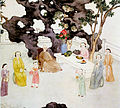Longhua (collar)
This article needs additional citations for verification. (March 2020) |
| Longhua | |||||||
|---|---|---|---|---|---|---|---|
 Qing Empress dowager Cixi (right) and Empress Longyu (middle) wearing longhua collar, Qing dynasty,1900. | |||||||
| Traditional Chinese | 龍華 | ||||||
| Simplified Chinese | 龙华 | ||||||
| |||||||
| Alternative Chinese name | |||||||
| Chinese | 龙华领巾 | ||||||
| |||||||
Longhua (龍華) were white, scarf-like collars worn by Manchu women in the early to mid-Qing dynasty. It was worn all year around when robes without collar were worn.[1]
History
[edit]Robes and jackets in the Qing dynasty were generally round-necked.[2] Clothing with high collars or neckbands already existed since the late Ming dynasty, however, in Qing, high collar clothing were only worn on an occasional basis.[2] Detachable collars were therefore produced and sold separately from the garments.[2] They were then used for decorative purposes, for keeping its wearer warm and in formal official attire.[2] During the late Qing, the high collar was eventually integrated to both the clothing of the Chinese and the Manchu as standard features.[2] With the rise of collars in garments, longhua slowly disappeared in use.[1]
Gallery
[edit]-
Painting of a Manchurian Family, 1800.
-
Imperial portrait of the Worthy Lady Chun of Emperor Xianfeng wearing longhua, mid 1800s.
-
Concubines of the Xianfeng Emperor fishing at a pond.
-
Two ladies of Qing Chinese Imperial Court wearing longhua with Qizhuang, pre-1911.
See also
[edit]References
[edit]- ^ a b "The Inner Beauty of Chinese Traditional Costumes". ChinaCulture.org.
- ^ a b c d e Finnane, Antonia (2008). Changing clothes in China : fashion, history, nation. New York: Columbia University Press. pp. 92–93. ISBN 978-0-231-14350-9. OCLC 84903948.



